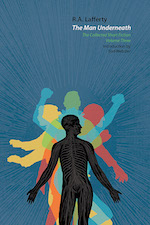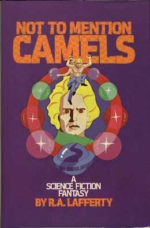If you look at the amount of words that have been written about him, it’s easy to conclude that R.A. Lafferty needs no introduction. There are, by now, probably as many introductions to and appreciations of R.A. Lafferty as there are books by the author. The introduction to Lafferty has almost become a genre in itself. Not only have major science fiction and fantasy writers like Neil Gaiman, Michael Swanwick, Gene Wolfe, Harlan Ellison, and Richard Lupoff all written about Lafferty, but Lafferty’s fans are some of the most active in the genre, publishing a biannual fanzine and organizing an annual Lafferty-themed con. The Guardian and the Washington Post have both covered him, and there are rumors of some forthcoming academic studies.
Why, then, have so few science fiction readers heard of Lafferty? Why am I writing another introduction?
 To answer that question, we have to take a brief look at what Lafferty wrote and how he wrote it. Saying that Lafferty wrote “tall tales” or “fisherman’s stories” is almost a cliché at this point, but there’s a reason these terms pop up again and again. Lafferty’s voice sounds much like that of an old man from the deep country sipping whiskey and spinning a yarn by a campfire. Folksy adjectives like “wooly” (for “crazy”) appear with great regularity; characters always have superlative traits—they are the bravest, or the wooliest, or the meanest—and adverbs (even “funfully”!) show up far more often than any conventional writing guide would approve. While there are recurring characters and even the occasional real-life historical figure, Lafferty generally prefers types to characters. That’s just as well, as very few authors could make us take characters named Willy McGilly, Barnaby Sheen, or Miss Phosphor McCabe entirely seriously. And, given the disasters that often befall Lafferty’s men, women, children, aliens, cities, states, and planets—one book is called Apocalypses (note the plural)—I’m not sure I want these characters to be realistic. As we learn in The Reefs of Earth, “A place like Earth will wilt the flesh off your bones unless you can make fun of it, or treat its persons and places as no worse than ghosts and ghost places.”
To answer that question, we have to take a brief look at what Lafferty wrote and how he wrote it. Saying that Lafferty wrote “tall tales” or “fisherman’s stories” is almost a cliché at this point, but there’s a reason these terms pop up again and again. Lafferty’s voice sounds much like that of an old man from the deep country sipping whiskey and spinning a yarn by a campfire. Folksy adjectives like “wooly” (for “crazy”) appear with great regularity; characters always have superlative traits—they are the bravest, or the wooliest, or the meanest—and adverbs (even “funfully”!) show up far more often than any conventional writing guide would approve. While there are recurring characters and even the occasional real-life historical figure, Lafferty generally prefers types to characters. That’s just as well, as very few authors could make us take characters named Willy McGilly, Barnaby Sheen, or Miss Phosphor McCabe entirely seriously. And, given the disasters that often befall Lafferty’s men, women, children, aliens, cities, states, and planets—one book is called Apocalypses (note the plural)—I’m not sure I want these characters to be realistic. As we learn in The Reefs of Earth, “A place like Earth will wilt the flesh off your bones unless you can make fun of it, or treat its persons and places as no worse than ghosts and ghost places.”
 A small handful of Lafferty stories, like the spider horror of “Once on Aranea,” might be summarized to sound like typical science fiction stories, but these are very much the exception. Other books and tales are very much odder. Lafferty’s first novel, Past Master, is about a future civilization resurrecting Thomas More to lead them away from Utopia. His short story “Slow Tuesday Night” describes a cartoonishly sped-up world whose inhabitants live out whole lifetimes of triumph and travail every day, while “Brain Fever Season” begins with some mad scientists discussing the revelation that “One of the hottest new items in the porno stores, not only in this country but worldwide also, is A Grammar of the Tibetan Language by A. Csoma de Koeroes,” and only gets stranger from there. Then there’s the story about the children’s game that ends the world. And the one about the hidden group of six-fingered time manipulators. And, of course, the one about Chicago, the dictionary, and mass forgetfulness. The very titles announce Lafferty’s originality: Try I as I might, I do not think there is any way to make a book called Not to Mention Camels sound like typical science fiction.
A small handful of Lafferty stories, like the spider horror of “Once on Aranea,” might be summarized to sound like typical science fiction stories, but these are very much the exception. Other books and tales are very much odder. Lafferty’s first novel, Past Master, is about a future civilization resurrecting Thomas More to lead them away from Utopia. His short story “Slow Tuesday Night” describes a cartoonishly sped-up world whose inhabitants live out whole lifetimes of triumph and travail every day, while “Brain Fever Season” begins with some mad scientists discussing the revelation that “One of the hottest new items in the porno stores, not only in this country but worldwide also, is A Grammar of the Tibetan Language by A. Csoma de Koeroes,” and only gets stranger from there. Then there’s the story about the children’s game that ends the world. And the one about the hidden group of six-fingered time manipulators. And, of course, the one about Chicago, the dictionary, and mass forgetfulness. The very titles announce Lafferty’s originality: Try I as I might, I do not think there is any way to make a book called Not to Mention Camels sound like typical science fiction.
The second reason that Lafferty remains relatively little-known is that, as fun as his stories are, they’re surprisingly difficult to read. While his later novels, which often came out from small presses, are notoriously hard to follow, even his early short stories have been called “mad.” From the very first word, these are strange tales indeed, and sometimes they can be tough to follow and harder to interpret. A patient reader can make sense of them, but they are not puzzles to be solved, or if they are puzzles, they are not just puzzles: Lafferty makes serious points, but never drily. Not every Lafferty story necessarily contains esoteric puns or hidden messages, but many of them do— and missing those elements sometimes renders brilliant stories mystifying or incomprehensible. When Lafferty does wax allegorical, it’s usually in the service of his traditional Catholicism, though his symbols are rarely doctrinaire one-for-one substitutions of the Aslan-for-Jesus sort. Unlike later Catholic SF writers like Gene Wolfe or Tim Powers, Lafferty is the product of pre-Vatican II Catholicism, and as such tends to make learned allusions to Latin and Greek—a tongue-twisting character name may hide a subtle theological point. Still, like all the best writers, Lafferty amply repays all efforts that a reader makes.
 The third reason you may not have heard of R.A. Lafferty is that his work is, for the moment, mostly out-of-print, hard-to-find, and expensive. Used paperbacks like Nine Hundred Grandmothers, his most famous collection, often go for thirty dollars online, while some of the novels sell for three figures. I’ve been able to put together a decent collection of his work without paying too much, but my collection been assembled through years of hunting in used bookstores. I bought one collection in the Strand’s rare book room, found an obscure novel for five dollars in an Ann Arbor store, emailed specialist bookstores, and guiltily danced out of a small bookseller after they sold me a hundred dollars of rare paperbacks for just $7.
The third reason you may not have heard of R.A. Lafferty is that his work is, for the moment, mostly out-of-print, hard-to-find, and expensive. Used paperbacks like Nine Hundred Grandmothers, his most famous collection, often go for thirty dollars online, while some of the novels sell for three figures. I’ve been able to put together a decent collection of his work without paying too much, but my collection been assembled through years of hunting in used bookstores. I bought one collection in the Strand’s rare book room, found an obscure novel for five dollars in an Ann Arbor store, emailed specialist bookstores, and guiltily danced out of a small bookseller after they sold me a hundred dollars of rare paperbacks for just $7.
I’ve enjoyed assembling my Lafferty collection, but my patchy library has taken six years to put together. Thankfully, it looks like future Lafferty readers will not have to go the same lengths to read his work: UK readers now have a dozen-plus titles available as ebooks, while US readers can enjoy the expensive Centipede Press limited editions of Lafferty’s stories. Let us hope that both sides of the Atlantic get more Lafferty in print—and soon! In the interim, good luck and happy hunting.
Matt Keeley reads too much and watches too many movies; he is helped in the former by his day job in the publishing industry. You can find him on Twitter at @mattkeeley.









